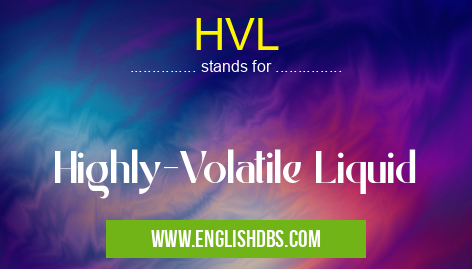What does HVL mean in TRANSPORTATION

HVL meaning in Transportation in Governmental
HVL mostly used in an acronym Transportation in Category Governmental that means Highly-Volatile Liquid
Shorthand: HVL,
Full Form: Highly-Volatile Liquid
For more information of "Highly-Volatile Liquid", see the section below.
HVL stands for Highly-Volatile Liquid, a term used in the government and industry to describe certain liquids that possess an unusually high degree of volatility. These materials are often hazardous, flammable, and corrosive and must be handled with extreme care. HVLs require special safety protocols and procedures when being transferred or stored due to their highly combustible nature. Understanding the characteristics of HVLs is essential for staying safe, as mishandling can lead to fires, explosions, and other potentially dangerous situations. In this article, we’ll discuss what HVLs are and what measures must be taken when working with these materials.
Types of Materials Considered as Being Highly Volatile Liquids
There are many different types of materials that may be considered HVLs depending on their composition and physical properties including alcohols such as methanol and ethanol; petroleum derivatives like gasoline; chlorinated hydrocarbons; ethers; ketones; esters; chlorine compounds; propane-based vapors; paint solvents; cleaning agents such as acetone or lacquer thinners; brake/transmission fluids; synthetic fluids like ethylene glycol coolants and antifreezes; turpentine products; adhesives/glues containing stabalizing agents like polyurethanes/acrylates/vinyl acetates etc.; nitrocellulose based finishes like lacquers/shellacs/clear coats etc., natural gas liquids (NGL), acrylic liquors etc. All these materials contain volatile components that make them prone to self-ignition in confined areas if exposed to sources such as sparks or open flames in addition to high temperatures brought about by increased pressure or direct sunlight exposure.
Precautions Required for Handling Highly Volatile Liquids
Due to their highly flammable nature, special safety protocols must be followed when transferring or storing any type of HVLS material from one location to another. When transferring large quantities it is best practice not only wear the appropriate personal protection equipment such as flame resistant clothing but also use specialized containers designed to limit vapor build-up during transport through features such as sealed caps with secondary containment vessels if possible.. Additionally personnel should receive proper training on how properly handle these materials through procedures such as ventilation control via fans with filters according local regulations and legal requirements in order prevent any potential risks caused by vapors getting into closed rooms or enclosed spaces where they may ignite due presence of heat sources.
Essential Questions and Answers on Highly-Volatile Liquid in "GOVERNMENTAL»TRANSPORTATION"
What is Highly-Volatile Liquid?
Highly-Volatile Liquids (HVLs) are fluids that have a high vapor pressure and the potential to produce vapors when exposed to air, oxygen, or other heat sources. HVLs present the risk of formation of an inflammable atmosphere if allowed to vaporize into a closed environment.
Are there any common HVLs?
Yes, some common HVLs include gasoline, ethanol, jet fuels, ketones and alcohols.
What are the properties of Highly-Volatile Liquids?
Highly-Volatile Liquids (HVLs) typically possess a flashpoint at or below 73 degrees Fahrenheit (23 degrees Celsius). In addition, they evaporate quickly and can form flammable explosions when exposed to air or oxygen in confined spaces.
What is the purpose of using Highly Volatile Liquids?
Highly Volatile Liquids are used primarily for their flammable properties and ability to create a large amount of energy in a short period of time. These liquids can be used for fuel and chemical production as well as fire suppression.
How do you determine if an unknown liquid has highly volatile characteristics?
If the unknown liquid has a flash point below 73 degrees Fahrenheit (23 degrees Celsius), then it should be considered highly volatile. Other indicators such as boiling point, smell, viscosity and color can also be used when determining if an unknown liquid is highly volatile or not.
How long can Highly Volatile Liquids remain stored safely?
The length in which High Volatility Liquids can be safely stored depends on many factors including type of container used for storage and how well ventilated it is during storage. Generally speaking, it's best to use the liquid within one year of purchasing it if possible to avoid fires or explosions during storage due to evaporation.
How should Highly Volatile Liquids be transported?
When transporting Highly Volatile Liquids, it's important that you use approved containers with proper seals and ventilation ports so as not to cause any fire hazards or explosions from contained vapors that could ignite en route. It's also recommended that you keep the transportation vehicle properly vented during transport and allow sufficient distance between vehicles whenever possible.
Are there any safety precautions I should take when handling Highly-Volatile Liquids?
Yes, when handling elevated volatility liquids it's important that you take all necessary safety measures such as wearing protective clothing/gloves/eye protection as well avoiding smoking near them; keeping them away from heating sources; ensuring adequate ventilation; limiting access only to authorized personnel etc.
Is there anything else I need to know about storing & handling HVLs?
Yes - before storing or transporting these liquids make sure you understand all relevant regulations regarding their management including permits required; labels; procedures & requirements for waste disposal etc.
What are some common disposal methods for HVLs?
Common disposal methods for HVls include incineration; absorption onto adsorbents such as activated carbon beds; deepwell injection; treatment with physical processes such as adsorption onto solid surfaces etc.
Final Words:
Highly Volatile Liquids (HVL) are substances possessing high enough vapor pressures making them extremely flammable under certain conditions while possessing low enough flash points making them liable for self ignition without any external ignition sources present in order words operate within environments outside standard recommendation levels therefore it's important for all personnel handling these classify materials follow very strict set guidelines labeled by relevant government organizations related product usage & transportation so as avoid potential fire disasters from occurring endangering people & properties around surrounding areas.
